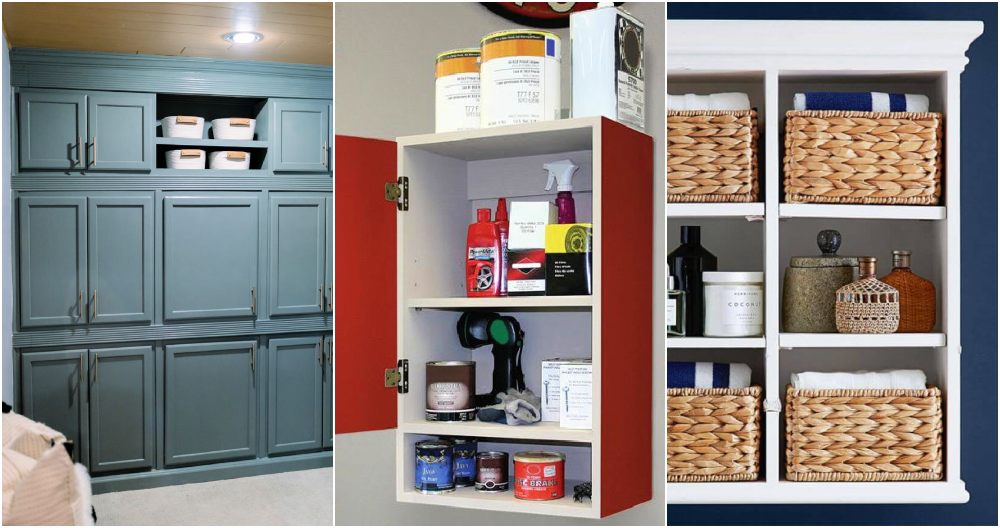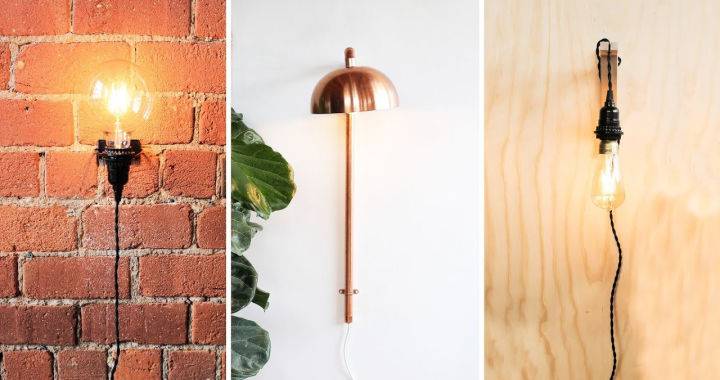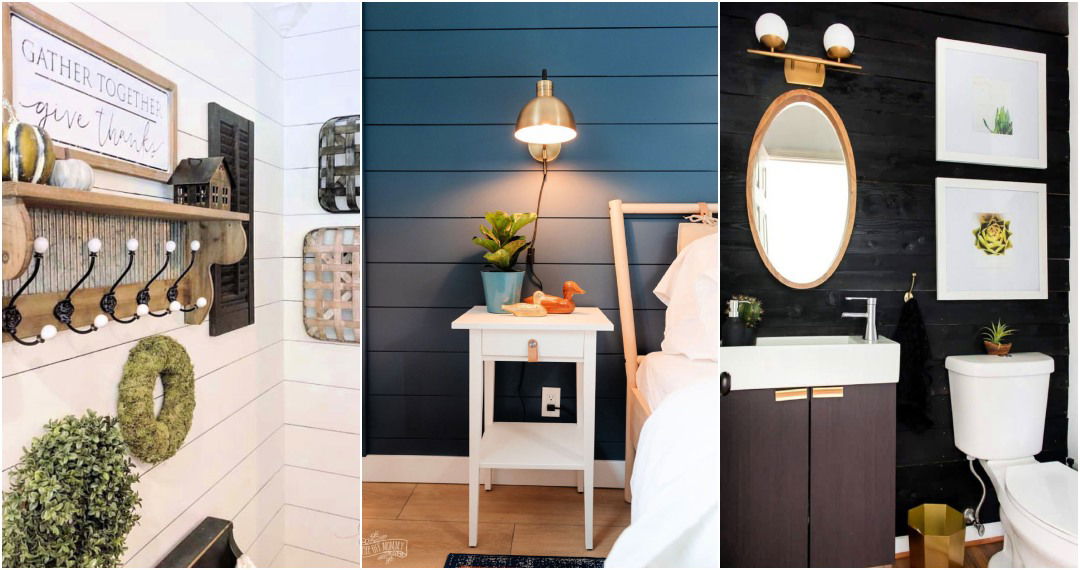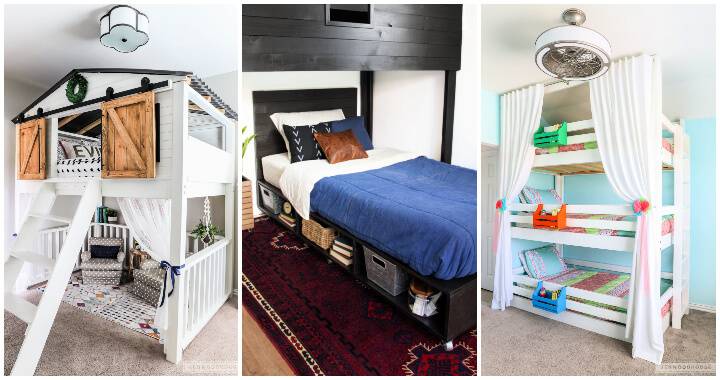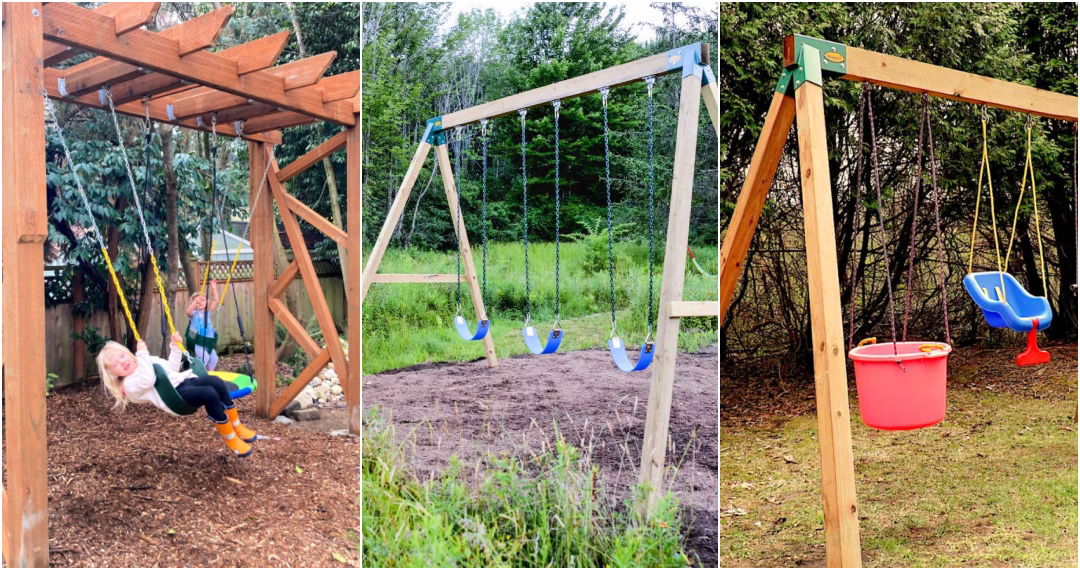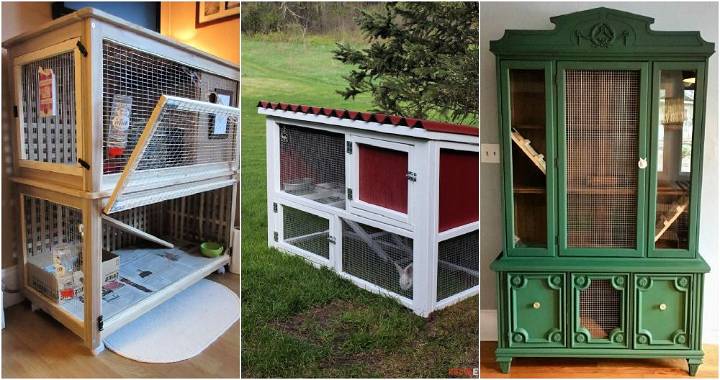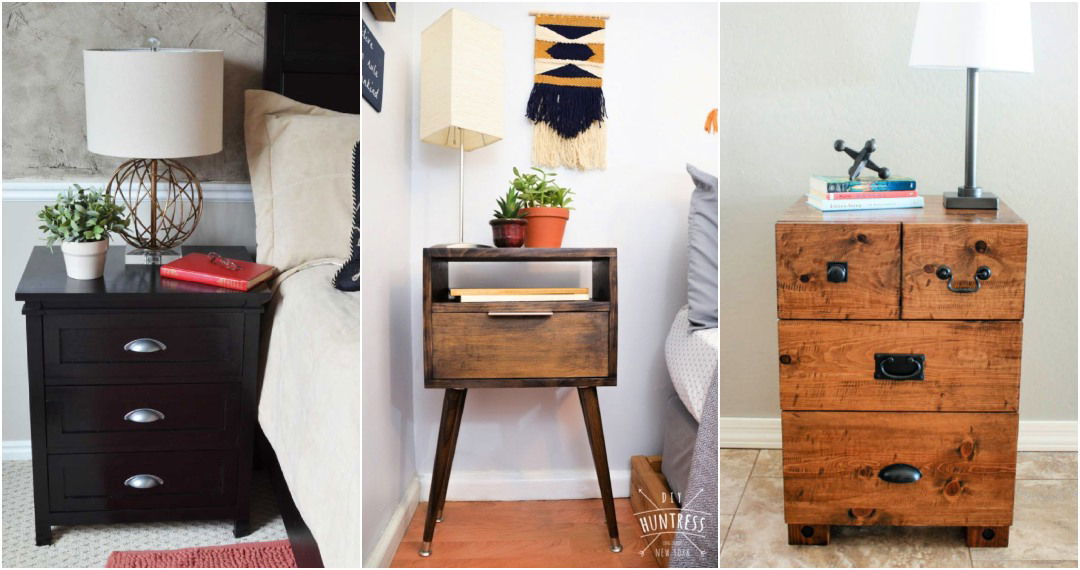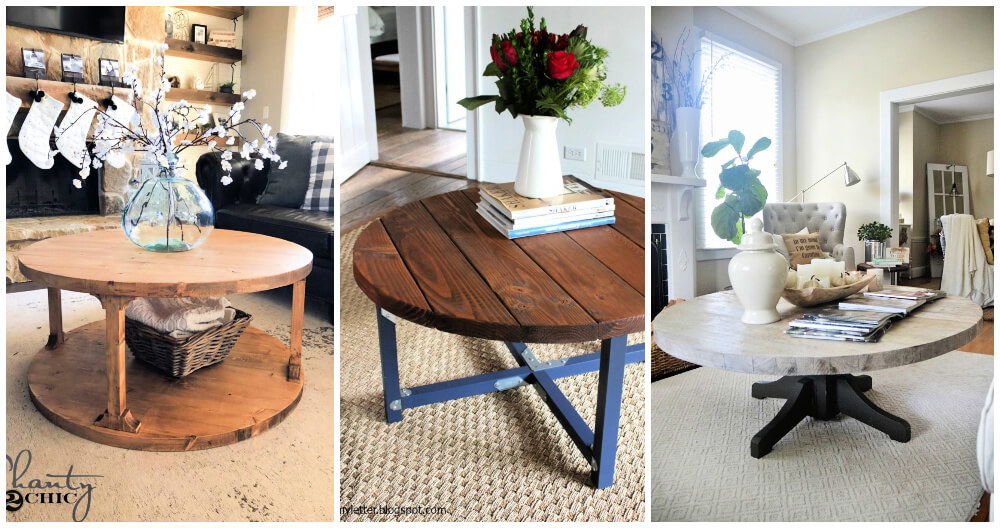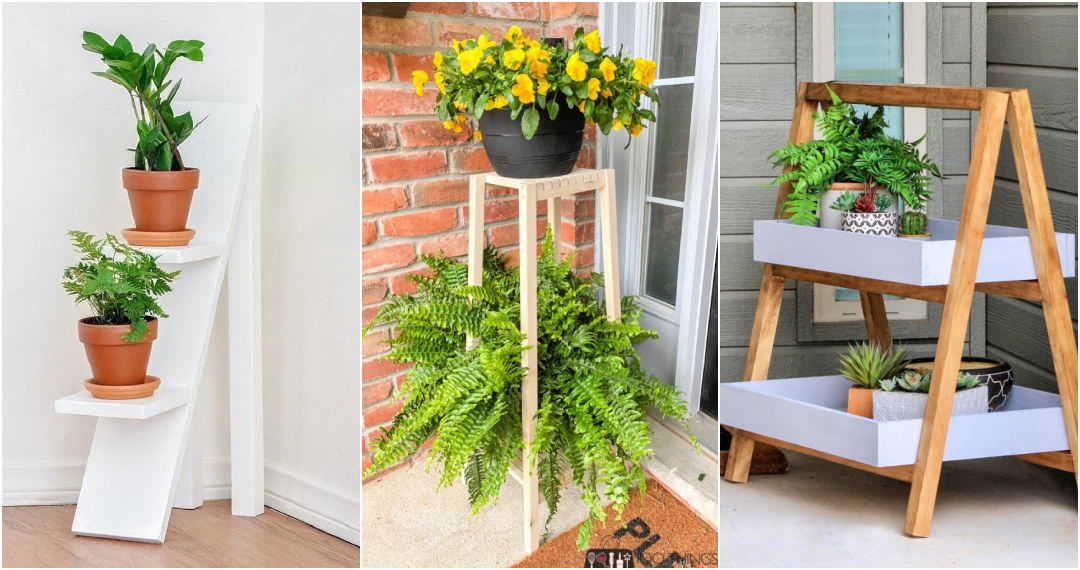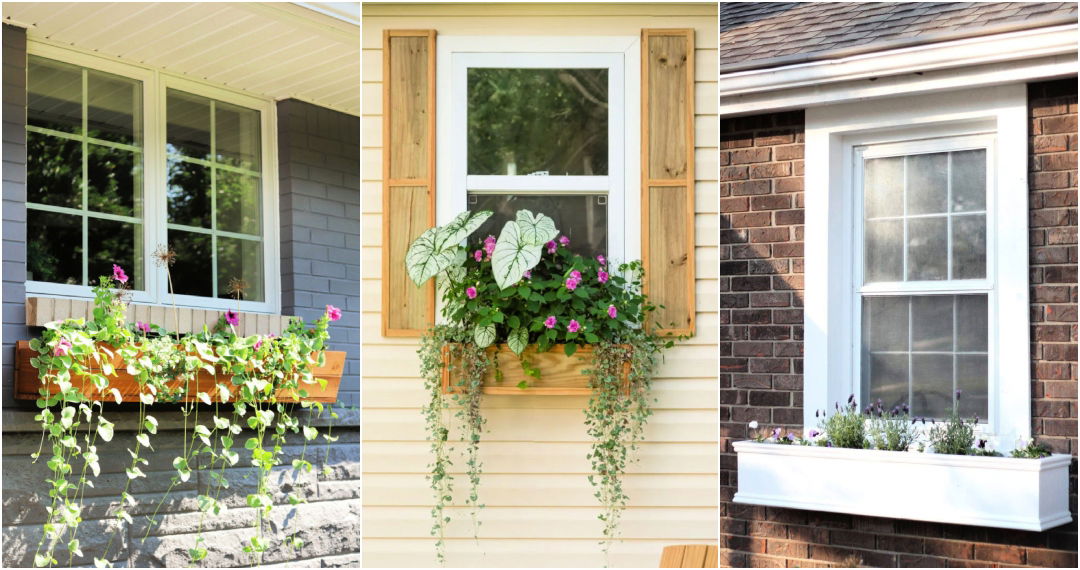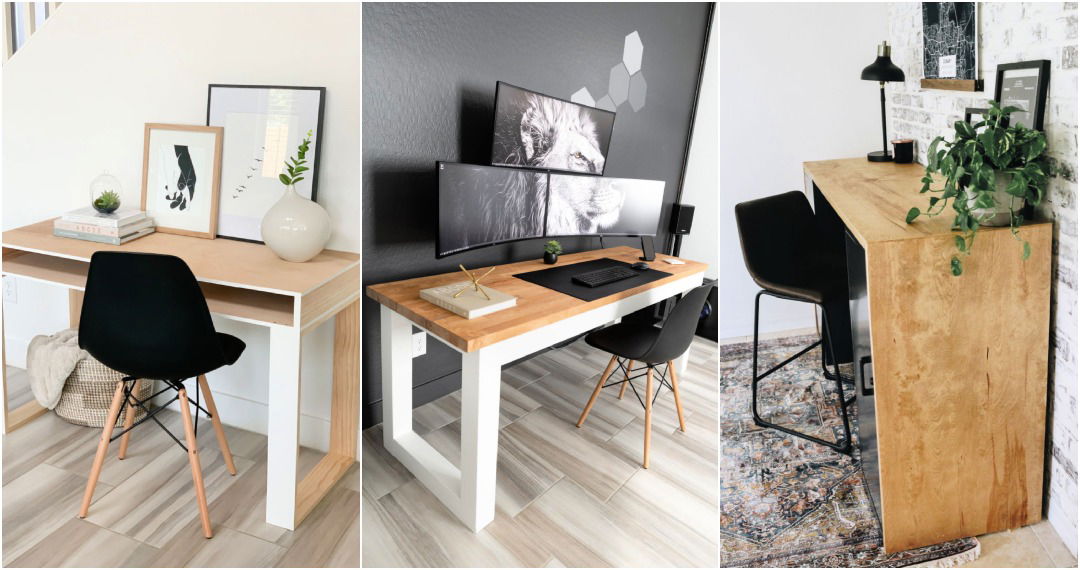Thinking about adding some excitement to your home or backyard? Building a DIY climbing wall might just be the perfect project for you. Not only does it offer a unique way to keep fit, but it also provides endless fun for family and friends. This guide outlines 25 DIY climbing wall plans to help you construct a safe and enjoyable climbing space, tailored just for you.
From planning and gathering materials to installing climbing holds, each step is crucial in building a sturdy and reliable climbing wall. Follow our simple and clear tips to ensure your project goes smoothly, whether you're aiming for an indoor or outdoor setup. Get ready to transform your space into an adventurous climbing zone! Continue reading to learn how you can begin building your very own climbing wall today.
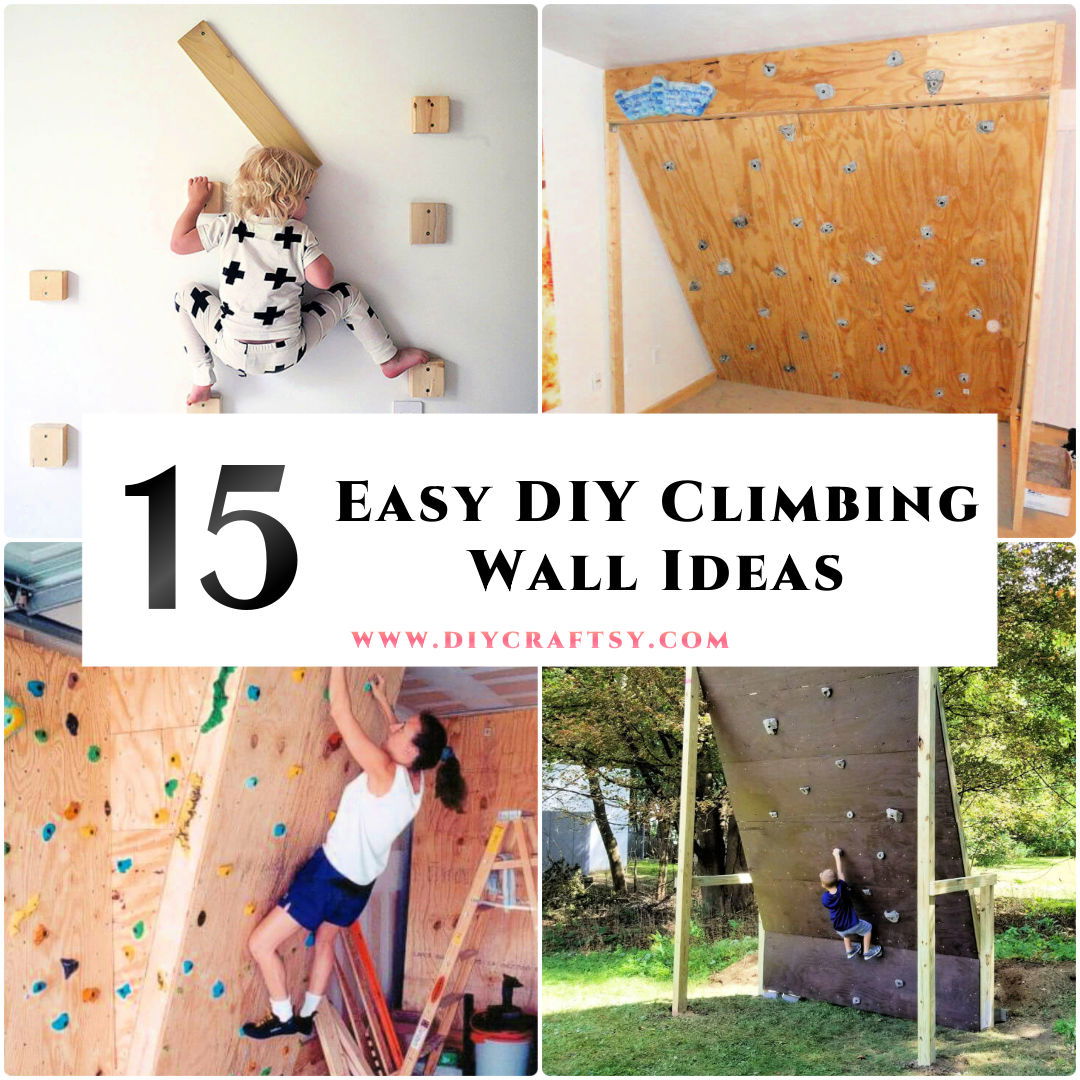
Why Build a DIY Climbing Wall?
Building a DIY climbing wall at home offers a multitude of benefits for both children and adults alike. Here's why taking on this project can be a rewarding experience:
- Promotes Physical Activity: In today's digital age, encouraging physical exercise is more important than ever. A climbing wall provides a fun way to stay active, improve strength, and enhance coordination.
- Enhances Problem-Solving Skills: Climbing is not just a physical challenge; it's a mental one too. Navigating routes fosters critical thinking and problem-solving abilities.
- Safe Environment: Having a climbing wall at home allows you to build a safe environment for climbing, where the risks are minimized under your supervision.
- Customizable: When you build it yourself, you can customize the difficulty levels, colors, and themes of the wall to cater to the preferences and skill levels of your family.
- Cost-Effective: Building a climbing wall at home can be more cost-effective than regular visits to climbing gyms, especially for families.
- Family Bonding: Working on a DIY project like a climbing wall can be a bonding experience for the whole family. It's an opportunity to teach kids valuable skills and work together towards a common goal.
- Boosts Confidence: For kids and adults alike, mastering a climbing wall can be a significant confidence booster, encouraging them to take on new challenges with enthusiasm.
Remember, the key to a successful DIY climbing wall is careful planning, choosing the right materials, and ensuring safety measures are in place. Happy climbing!
How to Make an Indoor Climbing Wall
Building an indoor climbing wall is a fantastic project to enhance any space while providing a great way for everyone to stay active. This step-by-step guide, inspired by "I Like to Make Stuff," will help you build a safe and fun climbing wall right in your home.
Step 1: Planning and Measuring
Start by thoroughly measuring the space where you intend to install the climbing wall. Pay special attention to the height, width, and any angular features of the space, like sloped ceilings. Sketching a quick diagram or even building a 3D model can significantly help in visualizing and planning the structure.
Step 2: Gathering Materials
Based on your measurements and plans, compile a list of the materials you'll need. Generally, this will include 2x4s for the frame, plywood sheets for the wall surface, framing nails or screws, a nail gun or drill, and climbing holds.
Step 3: Cutting and Framing
Begin by cutting your 2x4s to the necessary lengths for the wall's frame. Use a framing nailer or screw gun to assemble the base and vertical elements. Ensure all corners are square using a speed square, and adjust any angles for the top pieces to fit snug against the ceiling or sloped areas.
Step 4: Assembling the Wall Frame
Fit the frame pieces together on the ground first to get an idea of the final structure. If your wall includes angles or overhangs, measure and cut the 2x4s accordingly. Assemble using nails or screws, ensuring everything is sturdy and square.
Step 5: Installing the Frame
Position the frame against the designated wall area. If necessary, trim any existing baseboards for a flush fit. Secure the frame to the wall by driving long screws into the studs behind the drywall. This step is crucial to ensure the climbing wall's stability and safety.
Step 6: Adding the Climbing Surface
With the frame secured, attach plywood panels to build the climbing surface. It's a good idea to drill holes for the climbing holds beforehand, following an 8"x8" grid pattern to avoid the frame studs. Attach T-nuts in these holes from the backside to later screw in the climbing holds.
Step 7: Sanding and Finishing
Sand down all edges and surfaces to remove any splinters and ensure a smooth climbing area. Apply a coat of clear polycrylic to protect the plywood, leaving the option open to paint or customize the wall later on.
Step 8: Installing Climbing Holds
Once the finish has dried, you can start attaching your climbing holds to the wall. Experiment with different configurations to build a variety of paths and challenges. Remember, the safety of climbers is paramount, so ensure all holds are securely fastened.
Video Tutorial
For a visual guide on constructing an indoor climbing wall, watch this step-by-step video tutorial on YouTube.
It pairs well with this written guide, providing an additional perspective on the building process that can enhance your understanding and execution of the project.
Constructing an indoor climbing wall can be a rewarding project that adds fun and fitness to your home. Remember to plan carefully, work safely, and consult professional help if needed. Enjoy building and climbing on your new wall!
FAQs on Building a DIY Climbing Wall
Here we cover some of the most common questions you might have about building your own climbing wall at home.
What materials do I need to build a DIY climbing wall?
To build a basic DIY climbing wall, you will generally need:
- 2x4s for the frame
- Plywood sheets for the wall surface
- Climbing holds
- T-nuts for attaching the holds
- Screws or nails for assembling the frame and attaching the plywood
- A drill or screwdriver
- Sandpaper or a sanding tool for smoothing edges
- Safety equipment such as mats or crash pads
How do I ensure my climbing wall is safe?
To ensure the safety of your climbing wall:
- Secure the Frame: Make sure the frame is securely attached to the wall studs or the ground if it's a freestanding wall.
- Smooth Surfaces: Sand all surfaces and edges to prevent splinters and cuts.
- Stable Holds: Securely attach all climbing holds and regularly check them for any signs of wear or loosening.
- Protective Flooring: Use crash pads, mats, or a soft surface area beneath the climbing wall to cushion falls.
- Supervision: Especially for children, supervision is crucial to ensure they are climbing safely.
Can I build a climbing wall outdoors?
Yes, you can build a climbing wall outdoors, but you'll need to consider a few additional factors:
- Weatherproofing: Use weather-resistant materials such as treated wood and stainless steel hardware to prevent rot and rust.
- Sun Exposure: Consider the wall's orientation to avoid prolonged sun exposure, which can weaken holds and make the surface hot to touch.
- Ground Preparation: Ensure the ground is level and stable. For freestanding walls, consider anchoring the structure to the ground for additional stability.
How can I customize my climbing wall?
To customize your climbing wall:
- Vary the Hold Types: Use a mix of hold types (jugs, crimps, slopers) to build diverse climbing routes.
- Adjustable Difficulty: Plan routes of varying difficulty levels to cater to different skill levels and allow for progression.
- Themes and Colors: Paint the wall and choose hold colors to fit a specific theme or to blend with your room's décor.
- Add Features: Consider adding features like overhangs, volumes (angled blocks), or a crack for more variety.
How much does it cost to build a DIY climbing wall?
The cost of building a DIY climbing wall varies greatly depending on its size, materials, and whether it's indoors or outdoors. A small, basic indoor wall might cost as little as $200-$300, while a larger, more complex outdoor wall could cost $1000 or more. Budgeting for high-quality materials and safety equipment can also affect the overall cost.
Can climbing walls be taken down or moved?
Yes, climbing walls can be designed to be modular or temporary:
- Modular Walls: Design the wall in sections that can be easily assembled or disassembled.
- Freestanding Walls: Build the wall so it stands on its own, allowing it to be moved. However, these will need to be anchored or weighted down for safety.
- Removable Panels: Attach climbing panels to an existing structure using mounts that allow for removal when necessary.
Keep in mind that while movable walls offer flexibility, they also need careful planning to ensure they maintain stability and safety when in use.
How to Build a Climbing Wall: 25 DIY Climbing Wall Plans
Discover 25 DIY climbing wall plans and learn how to build a climbing wall at home with this comprehensive guide. Build your own climbing paradise today!
1. Build a Kids Climbing Wall
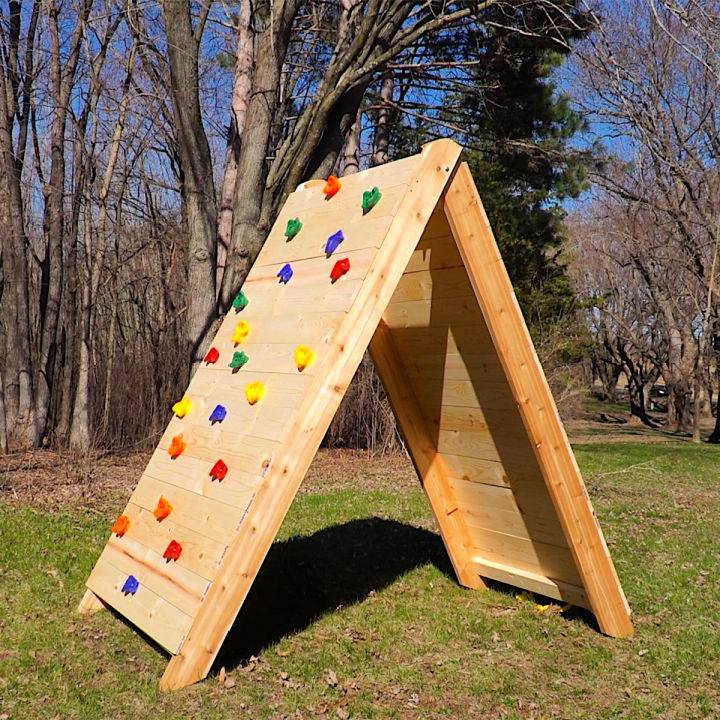
Transform your home into an adventurous playground for your kids with a DIY climbing wall! Family Handyman's guide provides a straightforward and enjoyable approach to building a folding A-frame climbing wall that promises endless fun and activity. Ideal for curing cabin fever, this project is perfect for families looking to add a dynamic element to playtime.
Suitable for various skill levels, this climbing wall ensures safety and entertainment for children while also serving as an exercise option for adults. Follow the step-by-step instructions, complete with a list of necessary tools and materials, to easily bring this climbing adventure to your backyard. Engage your children in active play and watch them conquer new heights right at home!
2. How to Make a Climbing Wall
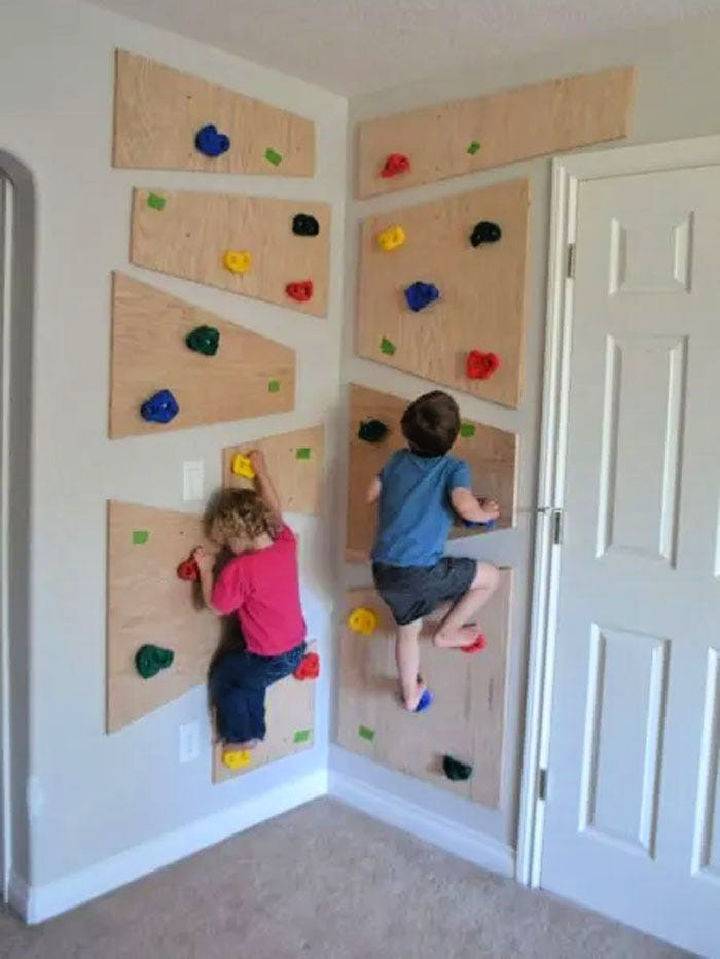
Transform your home into an indoor adventure park with a DIY climbing wall! The Created Home guides you through building a safe, enjoyable space for your little ones to scale new heights right inside your house. Learn how to plan, cut, and assemble a sturdy plywood structure, and discover the best way to arrange climbing holds for various age groups.
Plus, get a clever tip on child-proofing to ensure the wall is used under adult supervision. With this engaging project, you'll not only encourage physical activity but also build lasting memories as a family. Ready for the climb? Get your tools, gather your materials, and start building your own climbing wall for hours of active fun!
3. Building a Rock Climbing Gym for Kids or Adults
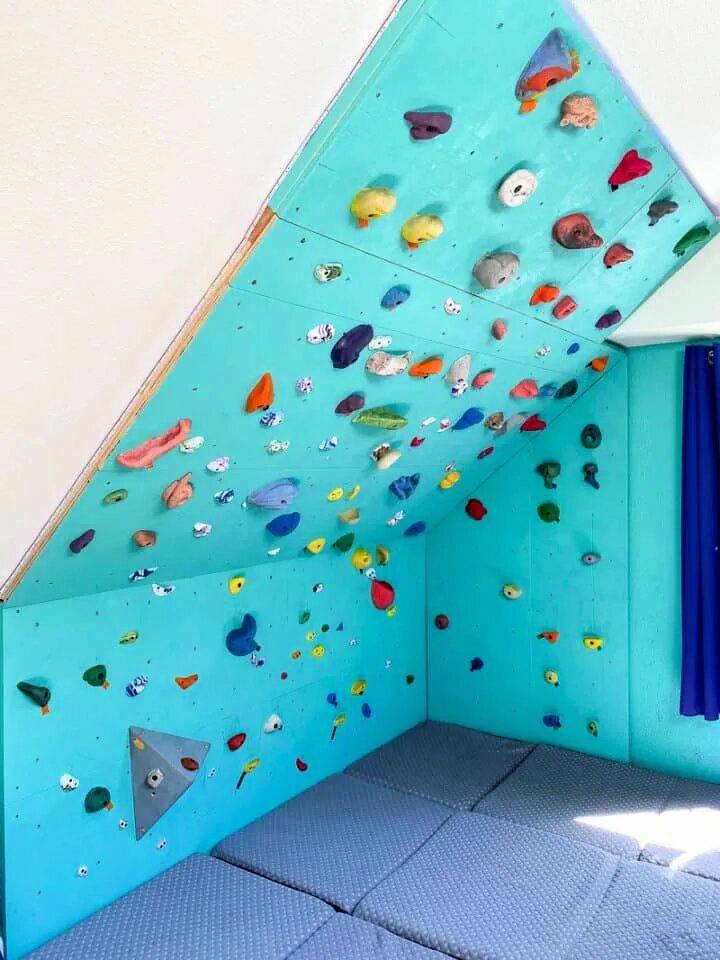
Building a DIY climbing wall at home is an excellent way to stay active and challenge yourself or keep kids entertained. The Handyman's Daughter, Vineta Jackson, provides a comprehensive guide on constructing a durable indoor climbing wall. This tutorial covers everything from framing to bolting and painting, ensuring a safe and enjoyable climb for all skill levels. By following these steps, you'll have the tools and know-how to build a personalized wall that caters to your climbing needs. Perfect for training or just having fun, a home climbing wall is a great addition to any fitness routine.
4. DIY Indoor Kids Rock Climbing Wall
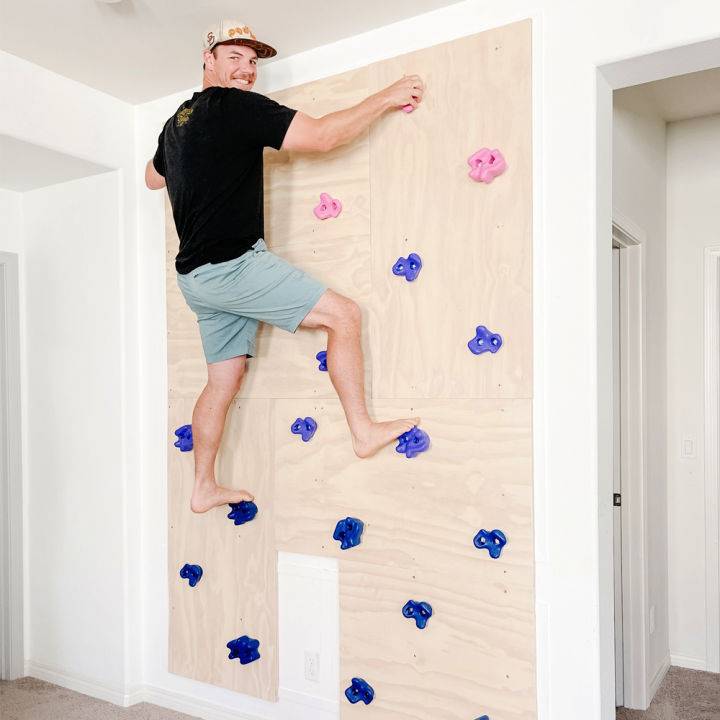
Elevate your home's play area with a DIY Indoor Kids Rock Climbing Wall, a thrilling addition that promises endless fun and physical activity for children. With essential materials like plywood, climbing holds, and safety mats, alongside tools such as a drill and screws, you can construct a secure and engaging climbing space.
This guide walks you through each step, from preparation to installation, ensuring a smooth process. Not only does it foster kids' strength and coordination, but it also sparks creativity and confidence. Ideal for any indoor space, this climbing wall transforms ordinary rooms into adventurous playgrounds, offering a unique feature that kids will love. Homedepot
5. DIY Kids Climbing Wall for a Treehouse
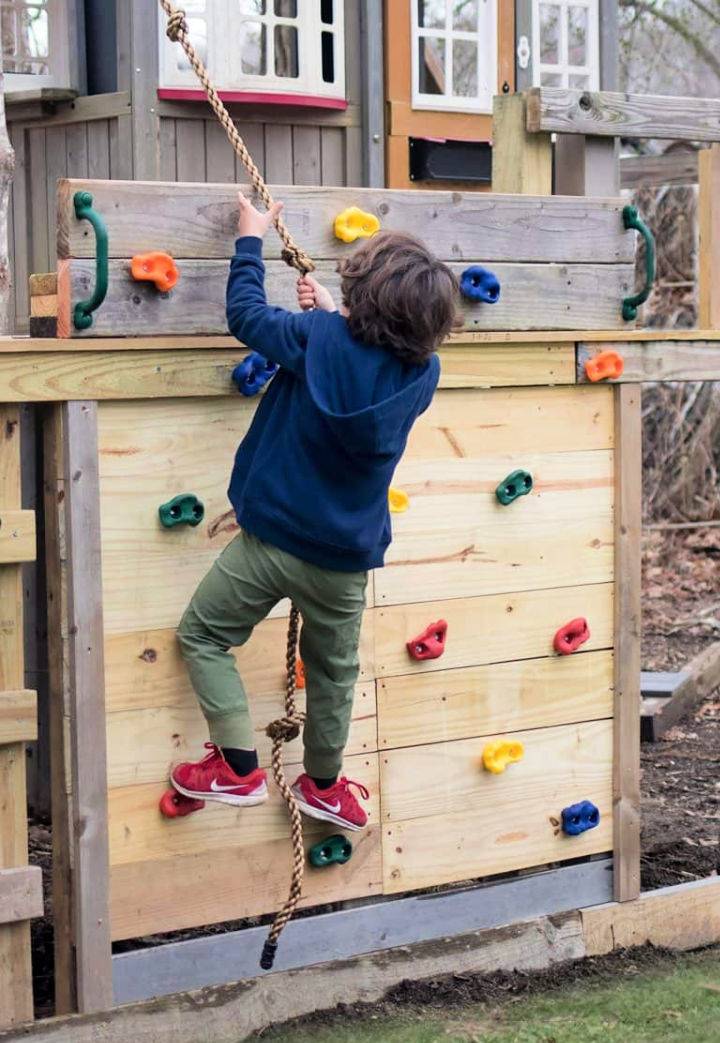
Transform your treehouse into a thrilling adventure for your kids with a DIY Climbing Wall, perfect for an engaging afternoon project. With clear instructions and a simple list of materials like 2x4s, 2x6s, deck boards, and rock climbing holds, this guide makes it easy to build a fun climbing feature. Customize the size to fit your treehouse and enhance it with a polished look using trim.
The included rock climbing kit, complete with holds, handles, and a rope, offers everything needed to get started. Perfect for families looking to add a touch of excitement to their backyard, this DIY climbing wall is sure to be a hit with the little ones, encouraging active play and imagination. Gina Michele
6. Indoor Kids' Climbing Wall
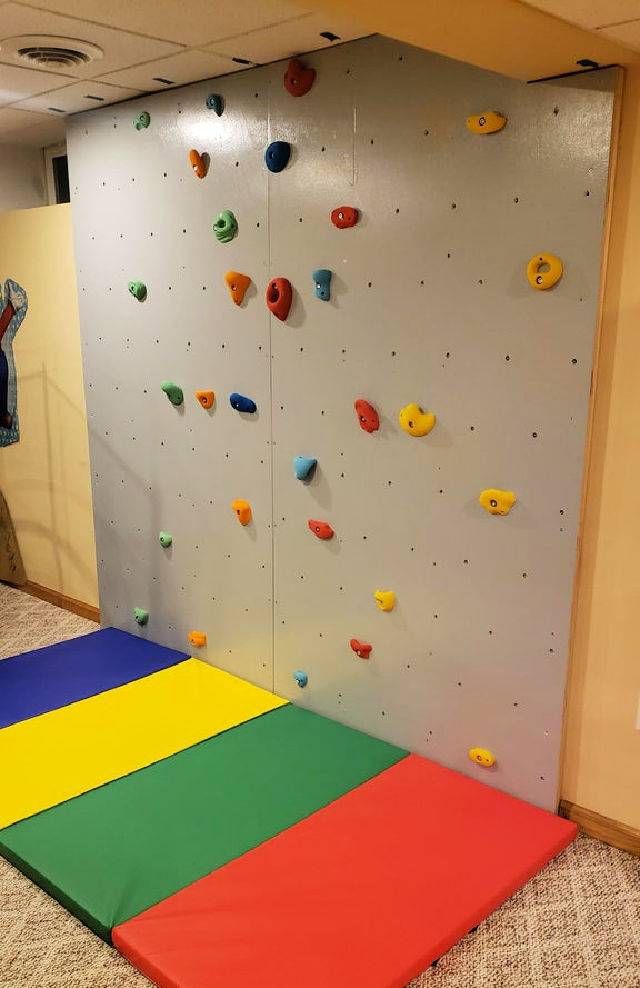
Transform your indoor space into a fun climbing haven for kids with this step-by-step guide from Instructables. Building a climbing wall at home can be a straightforward project, even for those with basic woodworking skills. Learn to choose a suitable location, plan the wall dimensions, and gather all necessary materials, such as plywood, studs, and climbing holds.
Follow simple instructions to attach 2x4s to your wall, drill holes in the plywood, and securely fit T-nuts for hold placement. With an option to personalize with paint, this DIY indoor kids' climbing wall not only promotes physical activity but also becomes a unique feature in your home. Safety is paramount, so ensure a proper mat is in place for cushioned landings. Engage the family in active play and build a space where your little climbers can thrive, all within the comfort of your home.
7. Handmade Rock Climbing Wall for Kids
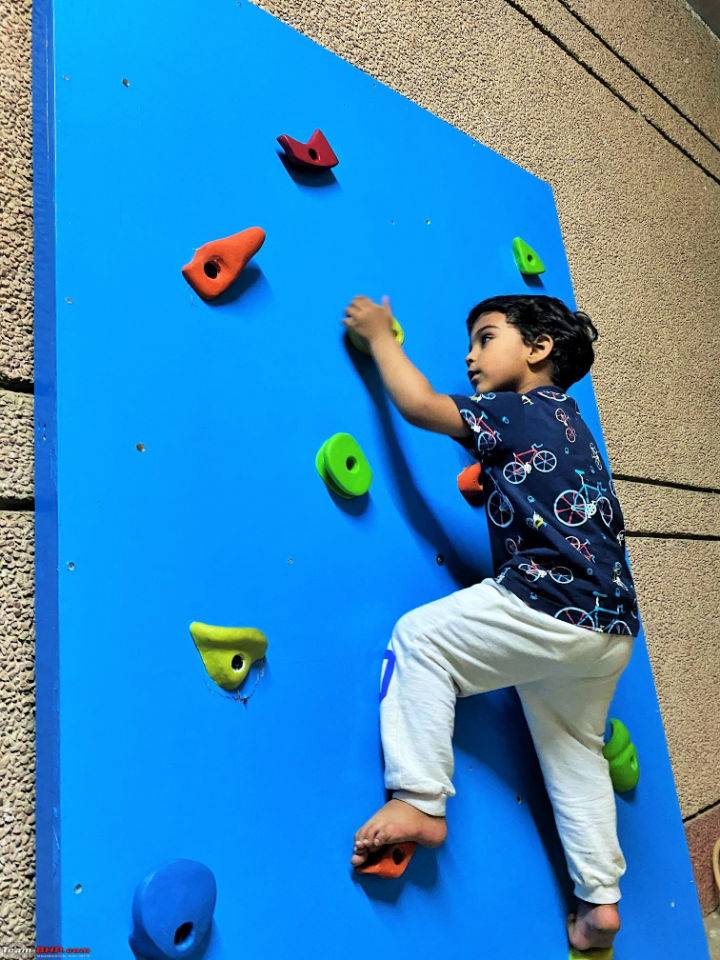
Making a rock climbing wall for kids can be an adventurous and rewarding DIY project. Team-BHP.com shares an insightful guide on how to construct a safe and enjoyable climbing wall for children. This hands-on activity not only provides an opportunity for kids to develop their motor skills and confidence but also serves as a unique and meaningful gift that stands out from the usual array of toys.
The guide is comprehensive, covering everything from design decisions to the final installation, ensuring your DIY climbing wall is both sturdy and visually appealing. Get ready to bring the excitement of climbing right into your home, where your little ones can enjoy hours of active fun.
8. Building an Indoor Rock Climbing Wall
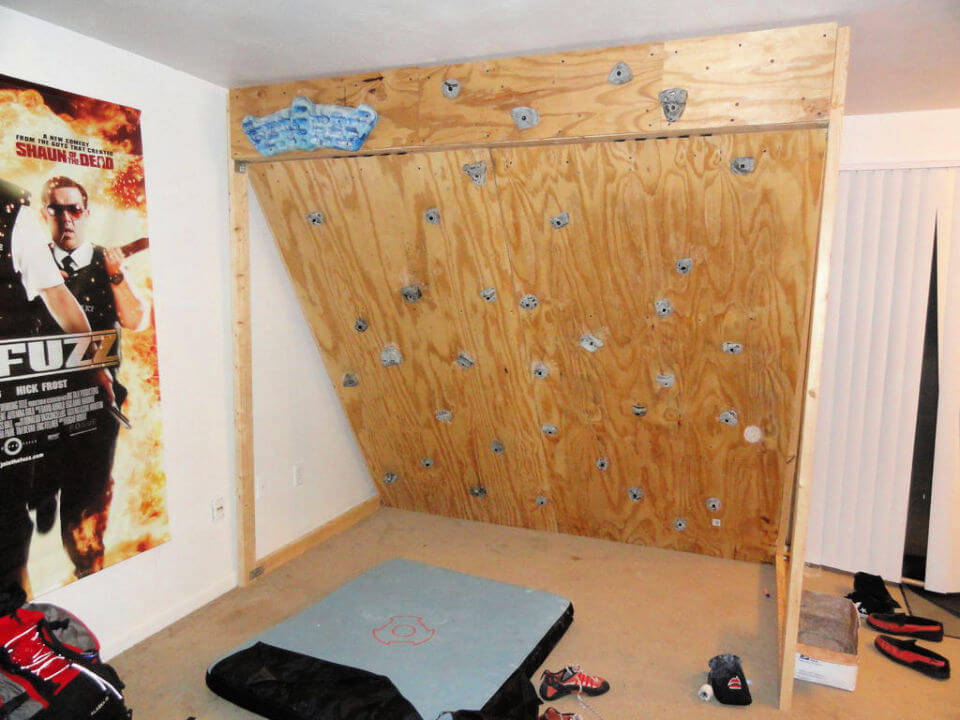
If you're passionate about rock climbing and keen to train at home, Instructables offers a practical solution with its guide to building a freestanding indoor rock climbing wall for around $150. The instructions are clear and detailed, making it easier for climbers of all levels to build a personalized space to practice and improve their skills.
This affordable project not only helps to save on gym fees but also allows for flexible training sessions in the comfort of your own home. With safety tips and equipment recommendations included, you can set up a secure climbing environment to tackle new challenges any time you like.
9. How to Make a Kids Climbing Ramp
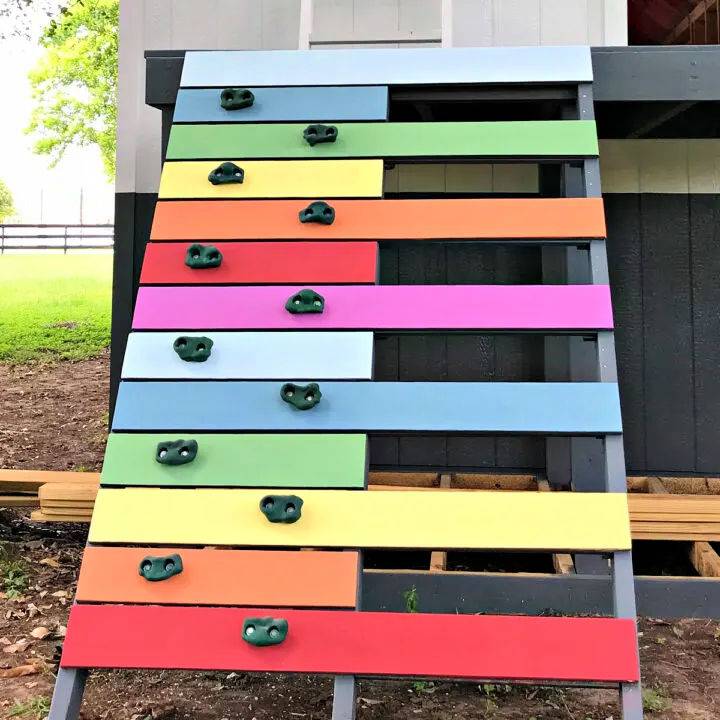
Discover how to build an exciting kids' climbing ramp for your backyard playset with guidance from Abbotts At Home. Stephanie Abbott provides a clear and engaging tutorial that includes easy-to-follow DIY steps, helpful images, and a build video. Ideal for enhancing outdoor play, this project utilizes materials like pressure-treated lumber and climbing rocks and introduces deck painting or staining for added durability.
Perfect for those seeking to build a functional play area, this ramp can be tailored with a gentle incline or as a vertical climbing wall to suit your child's adventurous spirit. This resourceful guide empowers you to construct a durable and enjoyable addition to your child's playhouse or fort, ensuring hours of active fun.
10. Kids Backyard Climbing Wall
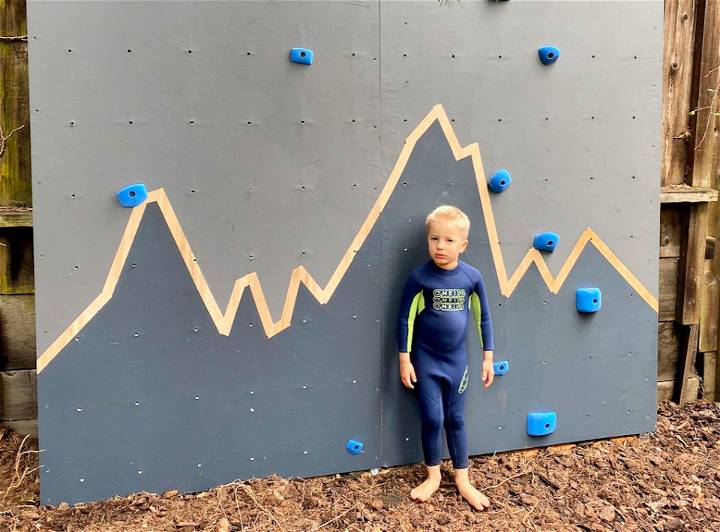
Transform your backyard into a fun-filled climbing adventure for your kids with Ari Tulla's DIY guide to building a backyard climbing wall. Perfect for those who have extra time at home, this project is an excellent way to keep children active and engaged outdoors. The guide is structured in a straightforward four-step process, starting with planning your project to fit your available space and moving through selecting the right materials, constructing the wall, and finally, starting the climbing fun.
With a focus on safety and enjoyment, you'll find detailed instructions on building a sturdy frame, preparing and painting the plywood, and securely mounting the wall. Priced at $400, including delivery, this project promises a rewarding and creative outdoor experience that will thrill the little climbers in your life.
11. Kids Inside Rock Climbing Wall With Mural
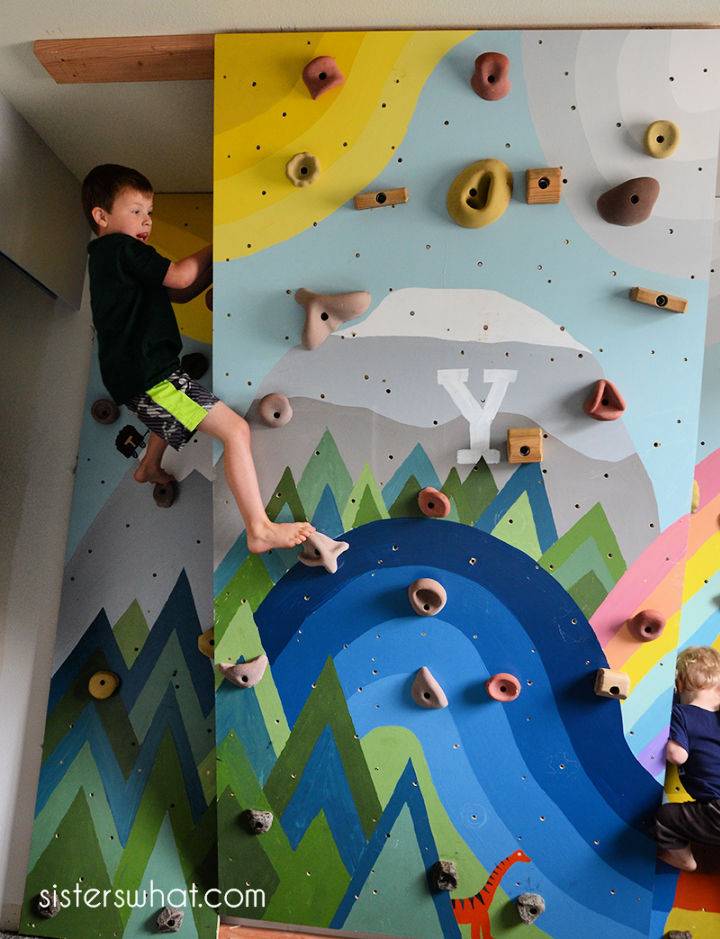
Transform your children's playroom into an adventure zone with a DIY indoor rock climbing wall. Sisters, What guides you through each step to construct a sturdy and safe climbing area, complete with a colorful mural to spark young imaginations? Learn to select the right materials, such as 3/4" plywood and reliable climbing holds from Rocky Mountain Climbing Gear and Synrock. Discover tips for installing t-nuts, painting, and adding protective finishes to ensure durability and safety. Perfect for enhancing motor skills and offering endless fun; this project is sure to be a hit with the kids. Follow the detailed instructions for an engaging playroom upgrade.
12. Build Your Own Climbing Wall
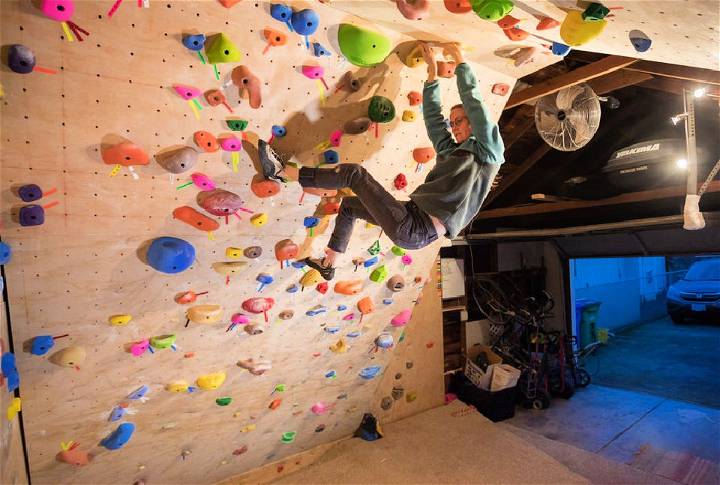
Ready to transform your home space into a climber's retreat? Climbing's guide on building a home climbing wall takes you through the essentials of planning and construction. Learn how to select the perfect space, design for a mix of training and fun, choose quality materials, and manage costs effectively.
This instructive read is packed with practical tips, from picking the right plywood to deciding on lighting and accessories. Perfect for busy parents or climbers far from a gym, a personalized woodie can keep your climbing passion thriving. Dive into Climbing's series for a comprehensive walkthrough on building your dream climbing haven.
13. How to Build a Climbing Wall for Kids
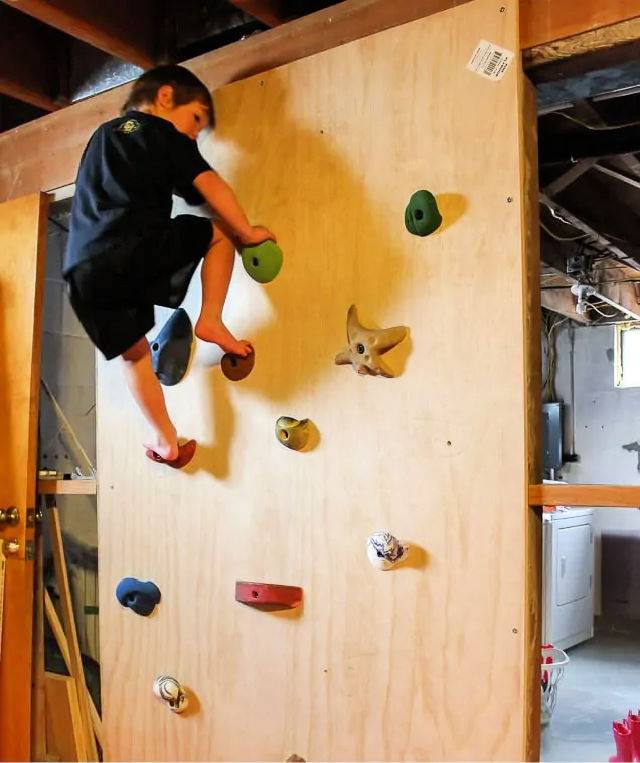
Transform your home into an adventurous playground for your little climbers with a custom-built kids' climbing wall. TwoFeetFirst guides parents through a detailed, step-by-step process to build a safe and engaging climbing area indoors. Gather your supplies, from climbing holds to sturdy plywood, and follow the straightforward instructions to securely install the wall.
This project caters to active kids, providing a fun outlet for their energy during colder months or any time indoor play is preferred. Simple to assemble and endlessly entertaining, a DIY climbing wall is an excellent addition to any family's play space, promoting physical activity and imaginative play.
14. DIY Rock Climbing Wall Murphy Bed
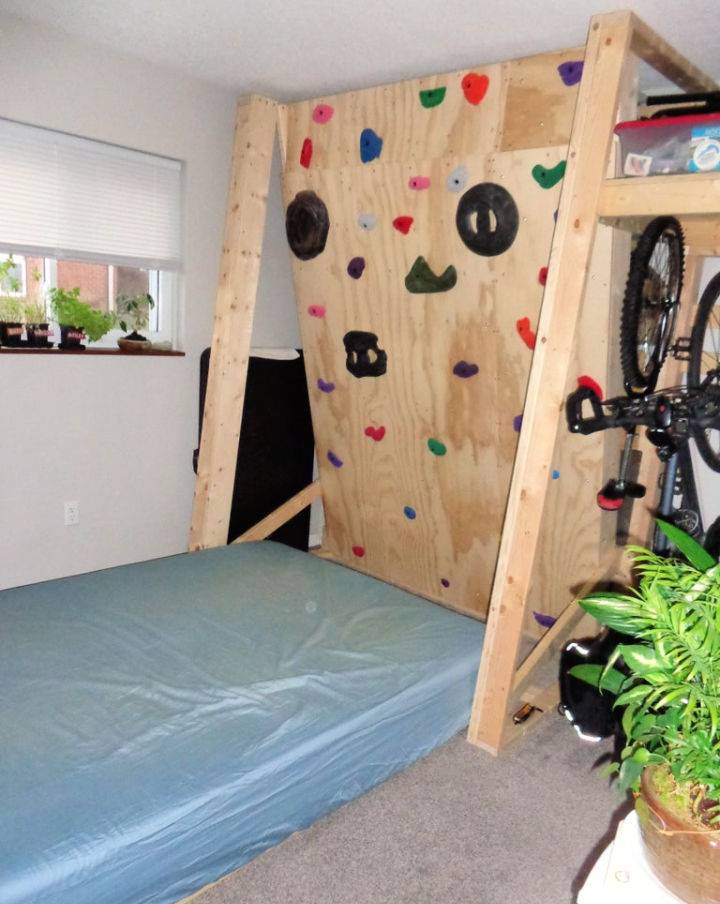
Transform your spare room into an adventurous climbing space with Instructables' guide to building a Rock Climbing Wall Murphy Bed & Vertical Bike Storage. Ideal for climbers and hobbyists looking to maximize space, this innovative design combines the thrill of climbing with the practicality of a guest bed and bike storage. The project is adaptable, with options to exclude the Murphy bed or bike rack if desired.
Step-by-step instructions ensure a user-friendly experience, making this project suitable for anyone eager to enhance their home with a multifunctional climbing wall. With detailed materials lists and cutting-edge construction tips, you'll have everything needed to start building a customized climbing area that doubles as a cozy retreat for guests.
15. Homemade Kids Climbing Wall
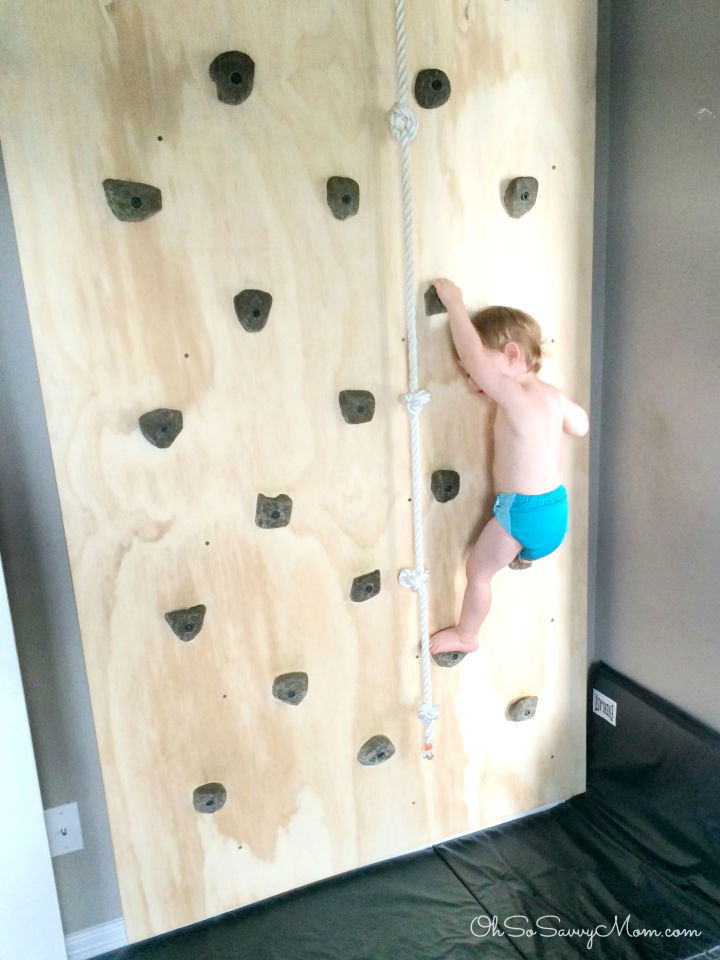
Make a fun and engaging indoor activity for your kids with a DIY Climbing Wall, courtesy of Oh So Savvy Mom. This tutorial provides easy-to-follow steps to help you craft a safe and sturdy climbing space that promotes physical development and adventurous play.
Perfect for rainy days or when outdoor escapades aren't an option, this project will not only keep your little ones entertained but also enhance their motor skills, coordination, and balance. With detailed instructions and a list of materials, you'll be able to assemble an exciting climbing wall that is sure to become the highlight of your home's play area.
16. How to Make a Rock Climbing Wall
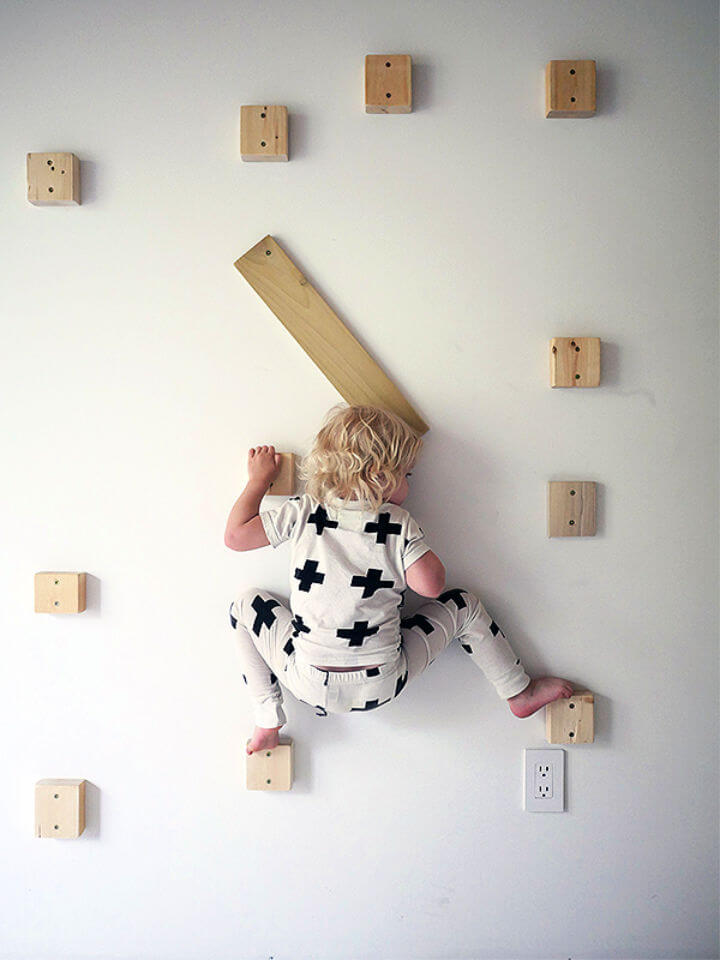
Transform your home into an adventure playground for your energetic toddler with a DIY rock climbing wall, courtesy of Design For Mankind. With simple materials like 2x4s, screws, and a bit of elbow grease, you can build a safe and enjoyable climbing space that challenges and entertains.
Follow our straightforward guide to cutting, sanding, and mounting your homemade "rocks" to a wall, using a stud finder for secure attachment. Perfect for little climbers, this project promises active fun and an exciting new feature in your home that your child will love. Get ready to watch your toddler develop their climbing skills right in the comfort of your bedroom!
17. DIY Super Mario Themed Climbing Wall
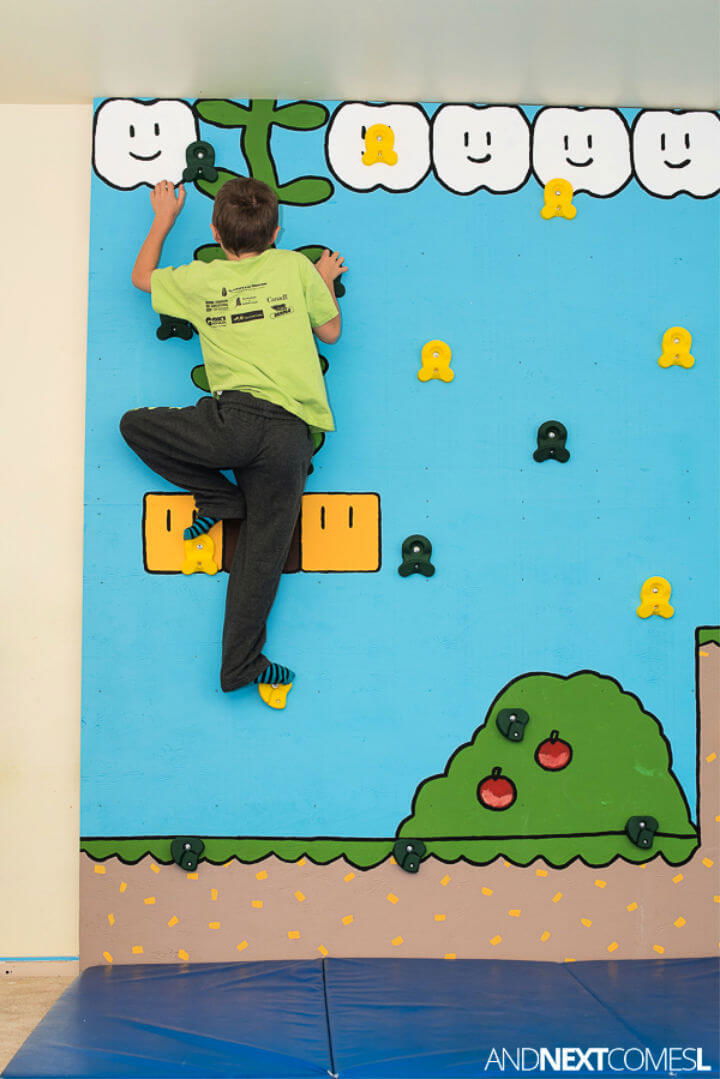
Eager to build a unique play area for your kids? Our DIY Super Mario Themed Climbing Wall is an engaging project that transforms any room into a fun adventure zone. With clear, step-by-step instructions, you can easily build an 8'x8' climbing wall in your basement or playroom.
The tutorial includes a detailed list of materials, from plywood to colorful climbing holds, and the tools you'll need. Plus, it offers creative painting tips to bring the Super Mario theme to life. Perfect for indoor fun, this climbing wall encourages active play and imagination in children. Let's get started on this budget-friendly, do-it-yourself climbing wall and build an exciting space for your kids to explore. And Next Comesl
18. Building an Indoor Rock Climbing Wall
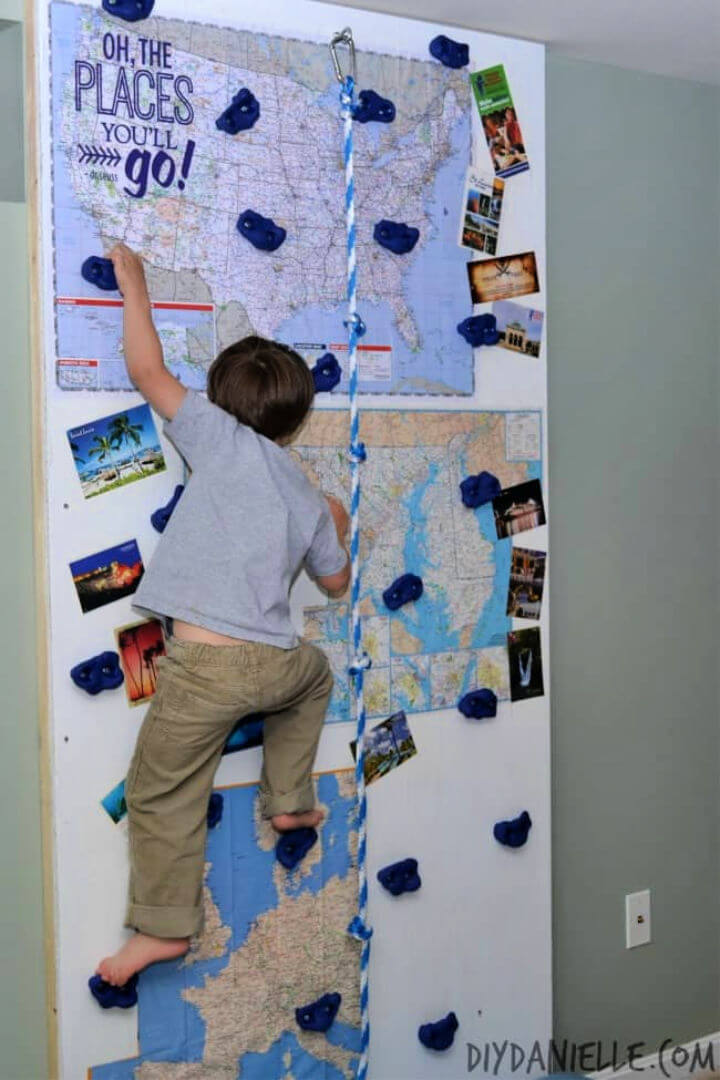
Transform your playroom into an adventurous space with a DIY indoor rock climbing wall! DIY Danielle® offers a step-by-step guide that's easy to follow, even for those new to DIY projects. Build a safe and enjoyable climbing area for your kids to burn energy during the colder months.
This project not only adds a fun element to your home but also serves as a unique wall decor. Learn how to construct a sturdy wall, select the right materials, and personalize it with a thematic touch. Keep your little ones active and engaged right at home with this affordable and rewarding DIY endeavor.
19. Make a Backyard Rock Climbing Wall
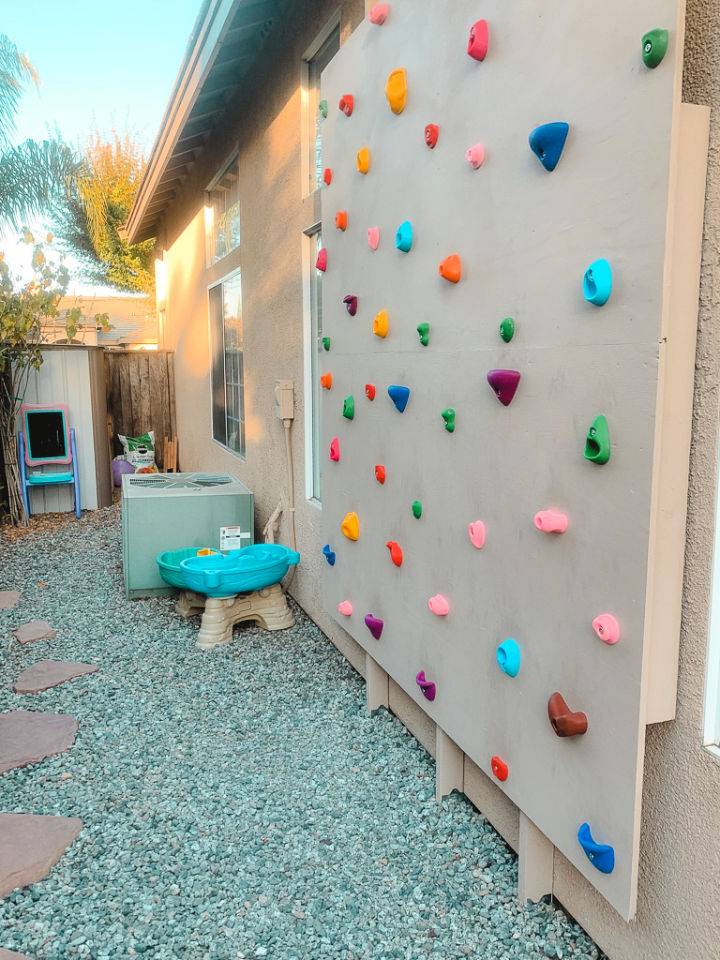
Transform your backyard into an adventurous play area with a DIY rock climbing wall for kids, as shared by Alia Sullivan on ali-ish. With a detailed step-by-step guide, you'll learn how to build a safe and exciting outdoor climbing space using affordable materials.
This project, costing under $200, will not only provide hours of fun for the little ones but also make great use of unused outdoor space. Discover how simple items like plywood, climbing holds, and basic tools can come together to form a sturdy climbing structure. For additional safety, consider adding a soft landing mat beneath. Dive into the engaging and instructive walkthrough and get ready to build an amazing climbing wall that your kids will love.
20. Build Your Own Home Climbing Wall
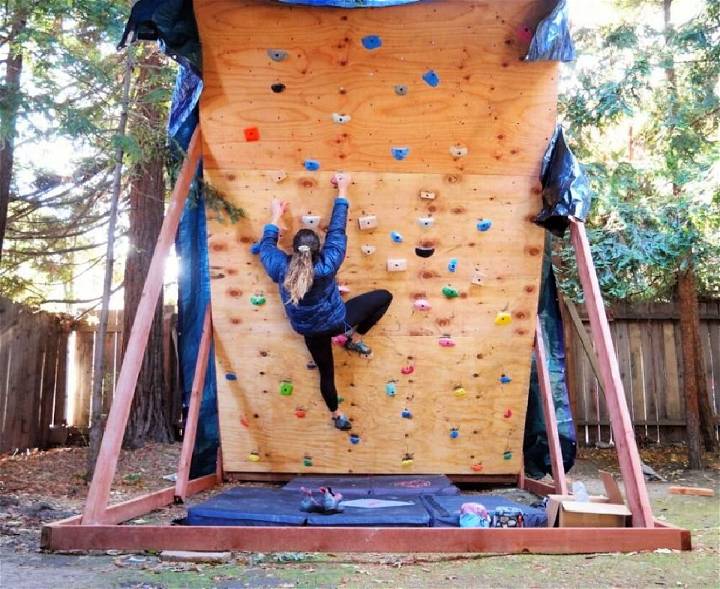
Ready to transform your space into an exciting climbing haven? Treeline Review's step-by-step guide on building a home climbing wall is your ultimate resource. With detailed instructions on planning, materials, and construction, this helpful walkthrough empowers DIY enthusiasts to craft their very own rock climbing setup.
Tailored to accommodate various skill levels and preferences, the guide provides valuable money-saving tips and insights to ensure your project is both fun and functional. Embrace the challenge and start setting up your personalized indoor bouldering gym today, following this instructive and engaging manual.
21. Build a Playroom Rock Wall
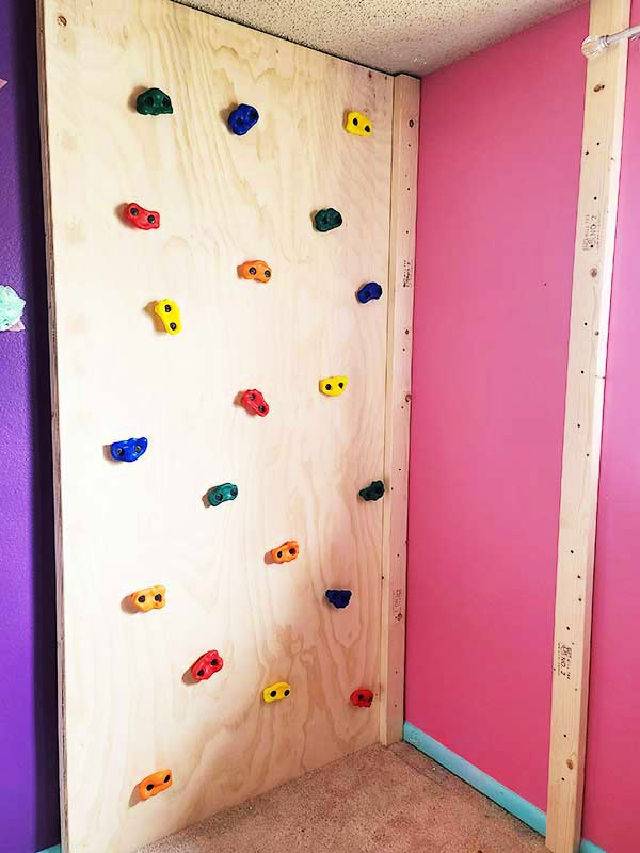
Making a playroom rock wall can transform your child's play area into an adventurous climbing zone, and Homemade by Huseman offers a thorough guide to help you with this project. In this tutorial, Ali Huseman takes you through the step-by-step process of constructing a rock wall that can be customized to fit any playroom or bedroom space.
The guide is tailored to be easy to follow, providing a list of materials, recommended tools, and practical tips to ensure a smooth installation. By adhering to these instructions, you can establish a safe and exciting climbing environment for your little ones right at home. With careful planning and a few hours of work, the rock wall will become a cherished addition to your child's playtime.
22. Make an Indoor Climbing Wall
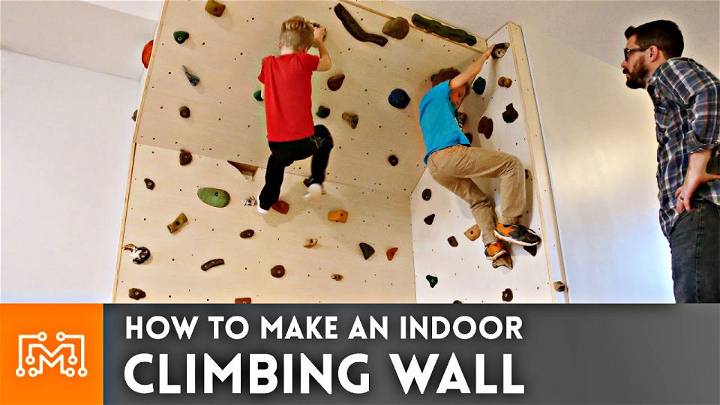
Craft your own indoor climbing wall to transform any room into an adventurous space! This guide walks you through selecting the right materials—plywood, two-by-fours, and climbing holds—ensuring your setup is both sturdy and engaging. Master the art of measuring, cutting, and assembling the frame to fit snugly against walls and ceilings, even adapting to unique angles.
Discover how to drill and install t-nuts for secure hold placement, offering endless fun and physical challenges. Perfect for enhancing a child's play area or adding a dynamic element to your home gym, building a climbing wall encourages active play and skill development, making it a rewarding DIY project.
23. Freestanding Indoor Home Climbing Wall
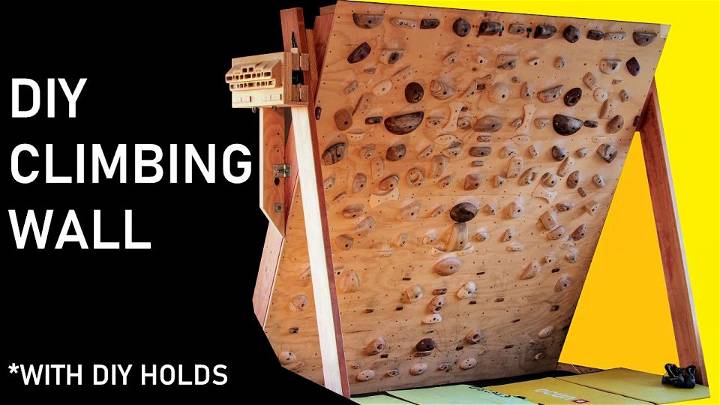
Elevate your home's fun quotient with a DIY free-standing indoor climbing wall, a fantastic project for those looking to add an adventurous twist to their living space. This guide walks you through building a sturdy and safe climbing haven, starting with a detailed framework construction using plywood and laminated two-by-fours for optimal support.
Essential tools and materials include studs, bolts, and a keen eye for precision to ensure everything is securely fastened, from the base to the top. Perfect for active families or anyone seeking a unique way to stay fit indoors, this climbing wall promises endless entertainment and a satisfying challenge to build.
24. Homemade Backyard Climbing Wal
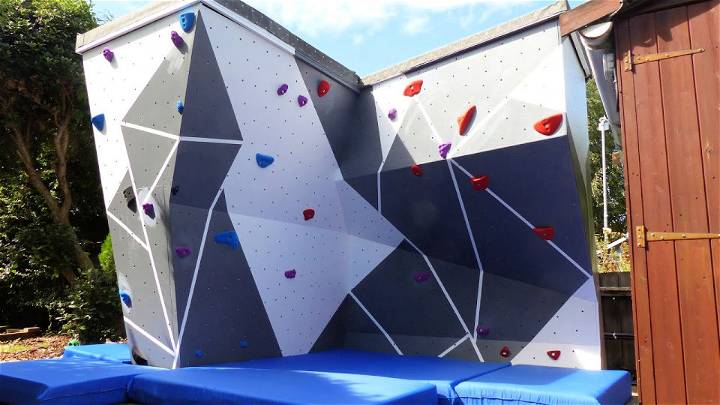
Embark on the adventure of building your own backyard climbing wall, an ideal project for those seeking a unique addition to their outdoor space. Crafted with a robust frame of 1-inch square steel box section and enveloped in 18 square meters of 18mm thick plywood, this project is designed to withstand the unpredictable British weather.
The addition of a waterproof roof equipped with a gutter system ensures durability. Complete with weatherproof paint, your climbing wall stands ready to challenge and entertain. Gather materials like steel, plywood, T nuts, and climbing holds to begin crafting this engaging structure that promises endless hours of climbing fun right in your backyard.
25. Backyard Climbing Wall
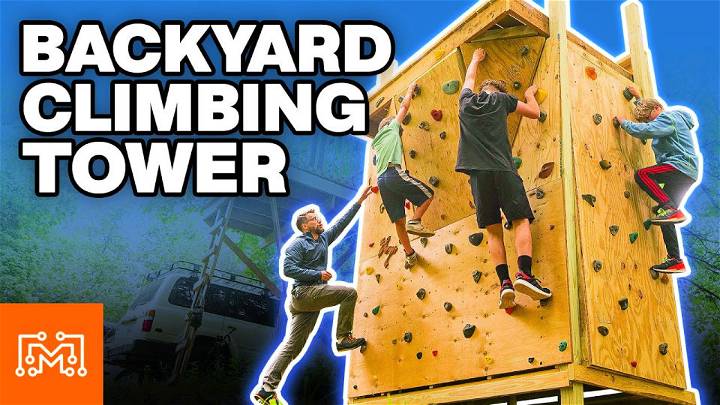
Elevate your backyard with a custom DIY climbing wall, perfect for outdoor adventurers of all ages. With straightforward materials like 4x4 posts, plywood, and climbing holds, this project turns any space into a thrilling vertical challenge. Begin by setting posts in concrete for stability, then frame your structure, ensuring dimensions accommodate standard plywood sheets for ease.
Whether incorporating overhangs for added difficulty or keeping it simple, this versatile design invites creativity. Complete the build with a mix of bolt-on and screw-on holds, making your climbing wall a personalized fitness and fun zone. Dive into this engaging build and build a lasting playground feature that promises endless outdoor excitement.
Frequently Asked Questions:
Get answers to your questions about constructing a DIY climbing wall for kids! Learn how to build the perfect structure with helpful tips and ideas from our experts.
How thick should plywood be for a climbing wall?
Plywood used for a climbing wall should be at least 3/4 inch thick. The thicker the plywood, the more resistant and durable it will be to wear and tear. It is also important to use high-quality plywood that meets safety standards to keep the climbing wall safe and secure. For optimal results, consider using 5-ply plywood. This type is the most durable and can withstand more weight than other types of plywood.
What do I need to build a rock wall for climbing?
To build a rock wall for climbing, you'll need climbing holds, anchor bolts, drill and screws, a sledgehammer, a level, an angle grinder with cutting discs and sandpaper, safety gear (such as gloves and eye protection), and plenty of patience! Ensure that the wall is built carefully to make it safe for climbers. Have fun building!
How to build a child's climbing wall?
To build a child's climbing wall, start by measuring and purchasing enough plywood to cover the designated area. Then add anchors for stability, attach hand holds in different patterns, mark routes with tape for visual guides, and apply foam padding to the bottom of the wall for protection. Finally, make sure to inspect the wall regularly to ensure its safety.
What wood is best for a climbing wall?
Birch plywood is the best choice for a climbing wall. It is strong, lightweight and very durable. Birch plywood also has good performance in terms of impact resistance and when exposed to moisture or extreme temperatures. It's easy to cut and shape as well, making it an ideal material for custom climbing walls. Overall, birch plywood is the best bet for any climbing wall.
Is it worth building a home climbing wall?
Yes, it is worth building a home climbing wall. Building one provides you with an easily accessible and enjoyable way to stay in shape. It also brings the fun of climbing indoors, making it always available for use regardless of weather or time constraints. Plus, it adds a unique touch to any living space!
How far apart should holes be on a climbing wall?
The spacing of holes on a climbing wall should be tailored to the user. Generally, it is recommended that the distance between two largest holds should be at least 12 inches, and the average distance between any two adjacent holds should not exceed 8 inches. It's also important to ensure adequate clearance between individual routes. This helps prevent hand or foot jams when transitioning from one route to another.
How do you make a simple climbing wall?
To make a simple climbing wall, you'll need to assemble the components - plywood, wooden posts, screws and anchor bolts. Then attach the posts to the plywood with screws and secure them with anchor bolts for stability. Finally, paint your wall or add texture for grip before enjoying your new climbing wall!
What angle should a child climb a wall?
The angle at which a child should climb a wall depends on the wall's surface and difficulty. Generally, it is best to start by climbing with an upright posture while keeping the body close to the wall. As they gain experience, kids can experiment with different angles—from vertical to more horizontal—to find what works best for them. Regardless of the chosen angle, safety is paramount; make sure there are no loose materials that could cause falling hazards.
Are toddler climbers worth it?
Toddler climbers can provide great learning and play experience for children. They're durable, entertaining, and can help develop physical coordination and social skills. Investing in a quality toddler climber is worth it if you want to give your little one an engaging and educational tool that will last.
How thick should a rock wall be?
The thickness of a rock wall depends on several factors, including the purpose of the wall, the type of rocks being used and the climate. Generally speaking, walls should be at least 8 inches thick to provide stability in most climates. However, thicker walls may be necessary depending on local conditions. Consult your local building codes for specific requirements.
Can you build a stone wall without a foundation?
Yes, a stone wall can be built without foundation. This is done by constructing the wall directly on the ground and using stones with sharp edges that interlock to keep the wall stable. It's important to ensure proper drainage when building this stone wall style. Otherwise, water buildup could cause erosion and weaken the structure's integrity.
The most successful stone walls are also reinforced with mortar or gravel for added stability. Adding reinforcement will help prevent displacement or cracking over time due to temperature changes or other sources of stress. If you plan on building a large stone wall, it's always best to build it atop a foundation for maximum structural integrity.
Can I use plywood for a rock wall?
Yes, you can use plywood for a rock wall. Plywood is durable, affordable and easy to install and maintain. It's also available in a wide range of colors and styles so you can customize the look to suit your tastes. Additionally, plywood is lightweight yet strong and impact-resistant, which makes it perfect for rock walls. You'll have a beautiful rock wall that lasts for years with proper installation!
Does layering plywood make it stronger?
Yes, layering plywood can make it stronger. Adding more layers of thin wooden sheets glued together increases the resistance to bending and impact damage. The result is a thicker, stronger material that has better structural integrity than a single piece of wood. It also reduces shrinkage and warping with changes in temperature and humidity.
How steep should a climbing wall be?
The ideal climbing wall angle is between 10-40 degrees, depending on the desired difficulty level. A steeper angle is better for more advanced climbers, while a less steep angle is better for beginners. Ultimately it's up to the climber and what they are comfortable with. It's important to make sure the wall can be climbed safely before attempting any climb. ~~~ End Word Count: 50 Words ~~~
Can you hang plywood instead of drywall?
Yes, you can hang plywood instead of drywall. Plywood is an excellent option for wall and ceiling cladding, offering good insulation and noise reduction. It's also easier to install since it doesn't require mudding or taping like drywall does. However, it's important to use the right type of sealant when installing plywood to ensure a lasting finish.
What are the 3 basic forms of climbing?
The three basic forms of climbing are bouldering, sport climbing and traditional (or trad) climbing. Bouldering involves ascending routes up to 20 feet in height with no rope or harness. Sport climbing is more technical and involves a rope and harness to ensure safety. Trad climbing requires specialized protection equipment placed into the rock as the climber progresses up a route. All three types provide different levels of challenge for climbers!
How do you make a cheap climbing hold?
Making a cheap climbing hold is easy! You will need some wood, screws, bolts and nuts. Drill holes in the wood for the bolts, then attach the holds using the nuts and screws. Make sure to check sand down any rough edges for safety, and you are ready to start rock climbing!
How are indoor climbing walls made?
Indoor climbing walls are typically constructed from plywood, fiber glass, steel and artificial rock materials. They often feature handholds and footholds to build routes of varying difficulty levels for climbers to follow. The walls may be angled in numerous directions and can incorporate features such as roofs, ledges and caves. Safety is a key factor when constructing an indoor wall, so quality materials and correct installation processes must be followed at all times.
What is the first rule of climbing?
The first rule of climbing is always to have a spotter who can monitor your safety and provide assistance if needed. It is important to wear the proper gear, like a helmet and harness, and practice proper rope-tying techniques. Always communicate with your partner during climbs and ensure you're aware of any potential hazards in the area. Safety should always be your number one priority when climbing.
What is the easiest type of climbing?
Bouldering is considered the easiest type of climbing. It involves short climbs that can be done solo or with a group and don't require any specialized equipment beyond climbing shoes and crash pads. Bouldering moves tend to be shorter and more dynamic than traditional rock-climbing routes, making it an excellent place for beginners to explore the sport.
What are the 4 levels of climbing difficulty?
Climbing difficulty is generally divided into four categories: beginner (5.0-5.7), intermediate (5.8-5.10a), advanced (5.10b-5.12a) and expert (5.12b+). Each level presents its own unique challenges, from proper technique to route finding skills and physical endurance levels, making climbing a rewarding activity for any level of ability.
Are female climbers better?
The debate over whether female climbers are better than male climbers has no definitive answer. All climbers, regardless of gender, have their own strengths and weaknesses in rock climbing. Every climber should focus on honing their skills and striving for improvement to achieve success. Gender does not affect the quality of climbing one can achieve. It is all about dedication and practice!
Is 2 too old for a Pikler triangle?
At 2 years old, a child's gross motor skills are well-developed enough to use a Pikler triangle safely. However, children's individual needs and learning styles differ, so it is important to consider your child's physical and mental development before investing in one. If in doubt, consult with your pediatrician or early childhood professional for advice.
At what age do climbers peak?
The age at which climbers peak varies but typically occurs between the age of 22-28. At this age, climbers are strongest physically and have developed their skills to a high level, giving them an advantage in competitions or on tough climbs. However, with experience and dedication, some climbers can remain competitive well into their 30s and 40s.
§ END OF DOC
What is the cheapest material to build a wall?
The cheapest material to build a wall is usually corrugated sheet metal, which is often lightweight and easy to install. It has the added benefit of being fire-resistant and resistant to rot and insect damage. It also requires little maintenance. Other inexpensive options include cinder block, brick veneer, or stucco. Whichever material you choose, make sure it fits the needs of your project and budget!
At what age can kids start with climbing walls?
Generally, most climbing walls recommend an age limit of 6 and above. However, this largely depends on the child's skill level and physical capabilities. Parents should always consult a qualified instructor to ensure their children can safely climb the wall. Additionally, there may be age restrictions at certain gyms or climbing centers. Check with your local facility for their rules and regulations.
Are Climbing walls safe?
Yes, climbing walls are safe when the proper safety precautions are taken. Following the best practices, like wearing a helmet and using approved harnesses, can help ensure a safe climbing experience. It is also important to inspect the holds and surfaces before climbing. Always be aware of your environment. With these precautions, climbing walls can provide an enjoyable and safe experience for all climbers.
Related DIY Projects and Ideas
Pallet Playhouse Plans: Make your kids' outdoor playtime super fun and exciting with these free DIY pallet playhouse plans! Easily build a dream backyard playground for less.
DIY Sandbox Ideas: Build an outdoor oasis with these easy DIY sandbox ideas! From a simple square sandbox to a more elaborate pirate ship, you'll find the perfect project for your backyard.
Cardboard House Ideas: Unlock your creativity with these unique DIY cardboard house ideas! From whimsical castles to cozy cabins, build a one-of-a-kind home that repurposes materials and stands out from the crowd.
DIY Ball Pit Ideas: Bring the playground to your living room with these fun & easy DIY ball pit ideas! Build a safe & budget-friendly space for kids to enjoy.
Play Kitchen Ideas: Keep your kids entertained and engaged with these awesome DIY play kitchen ideas! From colorful designs to fun repurposed materials, they'll love cooking up a good time.
Foosball Table Ideas: Make your own mini foosball table with these easy DIY ideas. Learn how to make a classic wooden tabletop game for hours of family fun!
DIY Chalkboard Ideas: Make a statement in your home with creative DIY chalkboard ideas. From crafts to wall art, these easy DIY projects are perfect for any skill level!
Conclusion:
In conclusion, diving into how to build a climbing wall and exploring 25 DIY climbing wall plans has hopefully ignited your enthusiasm for crafting your personalized climbing space. Whether your aim is to enhance your home's fun factor or to add a challenging workout element, these plans offer a practical roadmap. Remember, careful planning, selecting the right materials, and precise installation are key to ensuring safety and enjoyment for every climber. As you embark on this exciting project, keep in mind that each step taken brings you closer to achieving a remarkable climbing wall of your own. Happy building, and may your climbing wall bring endless joy and adventure!


